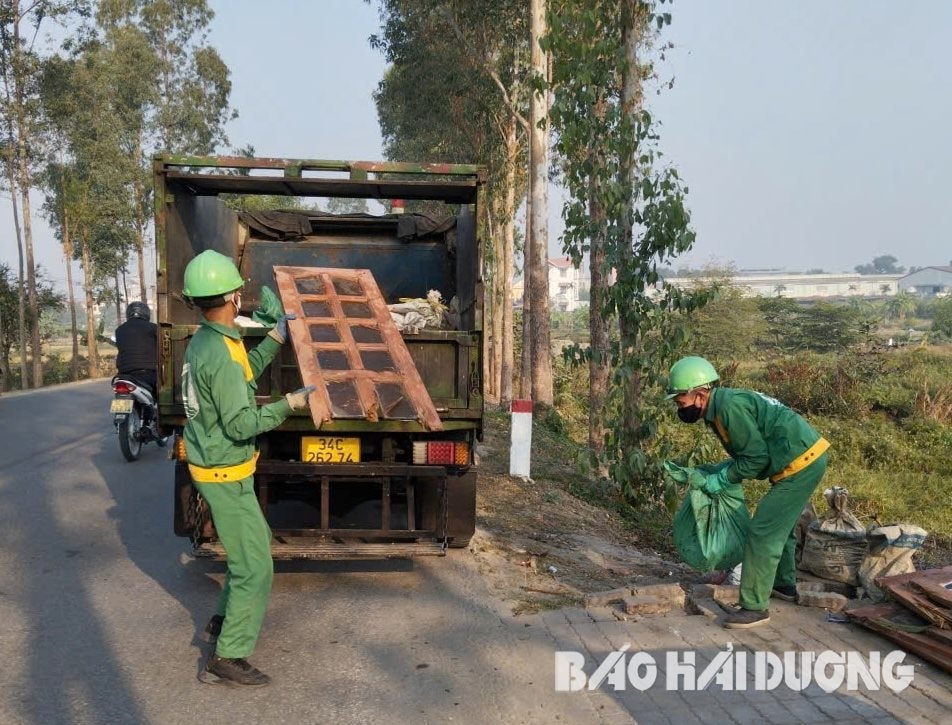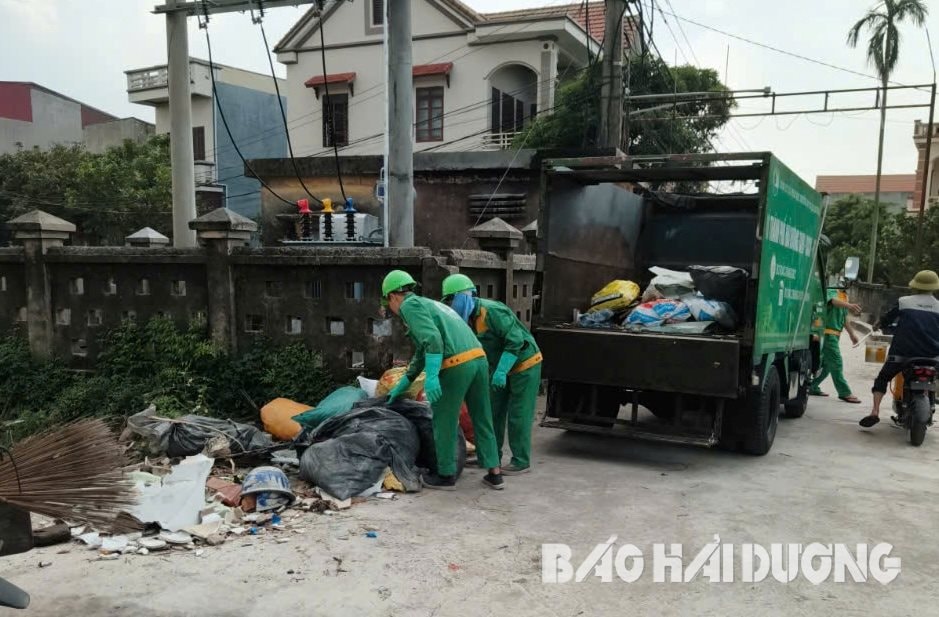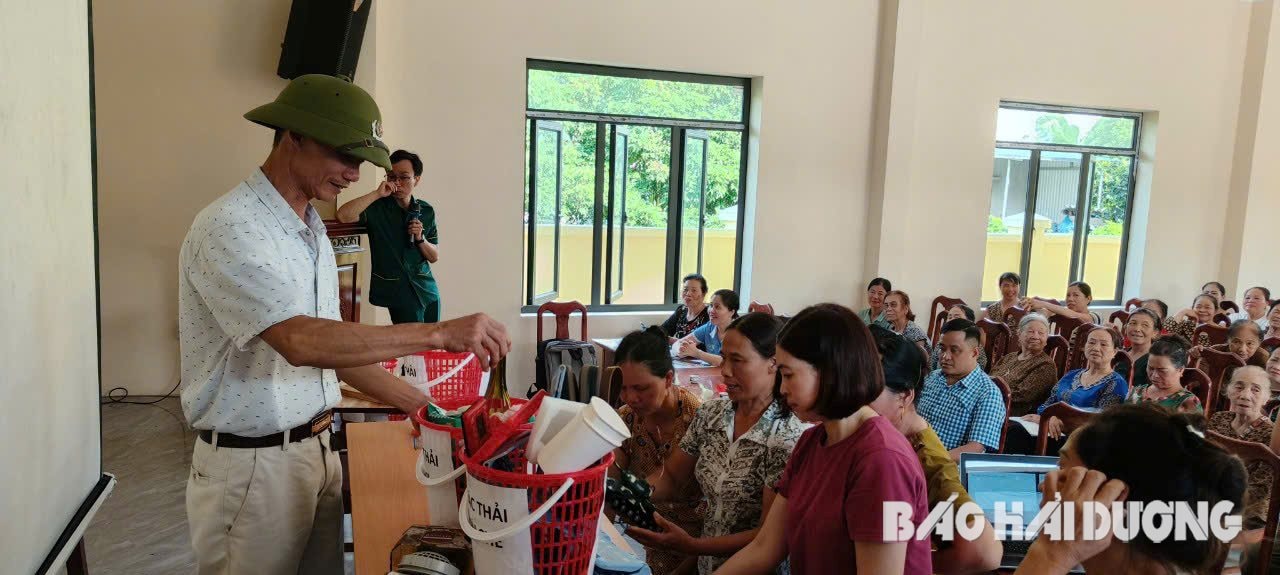Faced with difficulties from the reality of rapid urbanization, narrow area, and huge amount of waste, what does Hai Duong City do to achieve the goal of waste classification at source?

Divide into 5 types of garbage
According to the Law on Environmental Protection 2020, solid waste generated from households and individuals is divided into 3 types: solid waste that can be reused and recycled; food waste; other solid waste.
The regulation does not specify the difference in implementation between rural and urban areas, which means that it does not distinguish between the processing capacity of each locality. This is a shortcoming for urban areas in general and Hai Duong City in particular. Because in rural areas, waste is classified and can be completely processed at home with easily decomposable organic waste in the garden or composted in bins and used as fertilizer for plants.
However, in the city, it is different. Every day, Hai Duong City generates 230 tons of solid waste, 67% of which is organic waste. The classification of organic waste, food waste and centralized treatment at locations in the area using the composting method is not suitable due to the high level of urbanization; this treatment method has many disadvantages in terms of odor, leachate during the composting process, etc. Therefore, Hai Duong City only encourages households to do it themselves at home if they ensure the conditions of garden land and space. Therefore, in most areas of the city, waste must be brought to collection points and treated at the factory.
Identifying this difficulty, Hai Duong City has classified household waste into 5 types: waste that can be reused or recycled; hazardous waste; bulky waste; inert waste and remaining waste (including organic waste).
With waste that can be reused or recycled, waste source owners and households often sell scrap or leave it for garbage collectors to take away.

For hazardous waste generated from daily activities, there is very little. Currently, the city has planned a system of collection points with hazardous waste containers managed by Hai Duong Urban Works Management Joint Stock Company. In addition, villages and residential areas also arrange suitable reception points and are supported with hazardous waste containers from socialized sources. Hai Duong Urban Environment Joint Stock Company guides households to proactively bring hazardous waste to these points, and periodically the Urban Works Management Joint Stock Company will transport it for treatment.
For bulky waste, people must dismantle, reduce the volume, and bring it to the collection point before the collection date. Twice a month, Hai Duong Urban Environment Joint Stock Company will collect and transport it to a treatment location appropriate to the characteristics of each locality.
Similarly, inert waste is also brought to the receiving point for transportation for treatment. For the remaining waste, households put it in bags, drain the water, tie it tightly and leave it outside the door during collection hours for staff of Hai Duong Urban Environment Joint Stock Company to receive and take it to the treatment site.
In addition, for many years, city residents have had the habit of having their garbage collected daily, with all garbage being put in one bin or bag. To change this habit, Hai Duong City determined that it needs to be done gradually, from simple to complex, without causing residents to incur additional costs and effort.
Slow progress
According to the Law on Environmental Protection, from January 1, 2025, 100% of households must classify household waste at source. Hai Duong City and many other localities in the province cannot achieve this goal.
When implementing the “Project on domestic waste treatment in Hai Duong province in the period of 2021-2025, with a vision to 2030”, Hai Duong city was not included in the province’s pilot models. Therefore, the city implemented waste classification at source later than many other localities.
Hai Duong City People's Committee approved the Project "Classification of household waste and recycling of food waste after classification in Hai Duong City" in June 2024. The project's implementation progress was affected by storm No. 3.
Up to now, the city has organized training, propaganda and guidance on waste classification for people in 9 wards and communes in the suburbs, namely Gia Xuyen, Ngoc Son, Tan Hung, Lien Hong, Thach Khoi, Tien Tien, Quyet Thang, Tu Minh and Ai Quoc. After being trained and guided, the wards and communes have basically implemented the classification of solid waste at source according to the 5 types of waste mentioned above.

The City People's Committee also organized an online conference to train and guide the classification of domestic solid waste at source to the bridge points of the People's Committees of wards and communes so that the steering committee and propaganda teams can grasp and implement.
Initial assessment shows that people in the above communes and wards have been aware of complying with waste classification at home.
Up to now, Hai Duong Urban Environment Joint Stock Company has carried out dozens of separate trips to transport inert waste and bulky waste to separate treatment sites. The amount of waste generated from the three types of hazardous, inert, and bulky waste is very small. In Gia Xuyen and Ngoc Son communes, the amount of hazardous waste is less than half of a 240-liter bin, inert waste is about 2 1-ton trucks; bulky waste in Gia Xuyen commune is 1 1-ton truck of tree branches. In the remaining wards and communes, the initial implementation has not yet formed the habit, so the amount of waste generated from the three types above is even less.
Hai Duong City has also piloted recycling food waste into organic fertilizer in a concentrated area in Dong Bao village, Gia Xuyen commune from July 2024 to present. Food waste after being classified in households is partly brought to the Dong Bao village collection site for processing into organic fertilizer. After classifying, in September 2025, the city will hold a meeting to evaluate and summarize the results to draw experience and make adjustments for the next phase, in accordance with the practical situation.
According to Mr. Nguyen Thanh Do, Director of Hai Duong Urban Environment Joint Stock Company, the classification and treatment of household waste according to the above model of Hai Duong City may not have achieved a clear reduction in the amount of waste that must be treated at the factory. However, the most obvious result is that the city's environmental landscape has been significantly improved.
Hai Duong City strives that by the end of 2025, 100% of households will be educated and instructed on techniques for classifying household waste; 95% of households will classify waste into 5 groups and transfer it to collection units according to regulations.
To achieve the above goal, Hai Duong City continues to strengthen propaganda and mobilization activities to mobilize social resources for waste classification. To effectively classify waste at source, the city continues to synchronously deploy classification, transportation and treatment. The classification and separate treatment of food waste will lead to an output for organic fertilizer products...
BANK